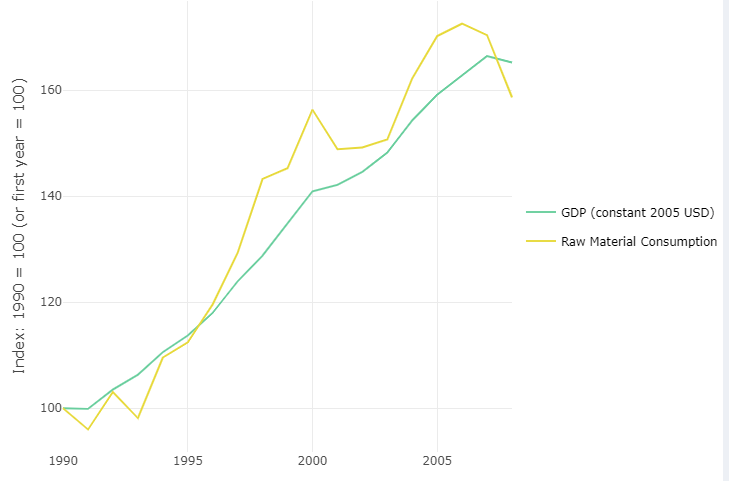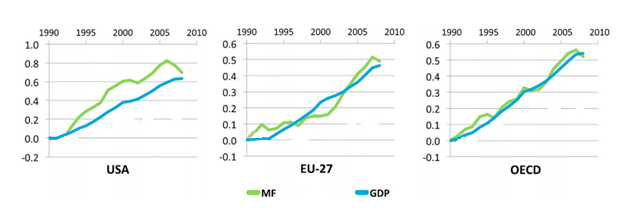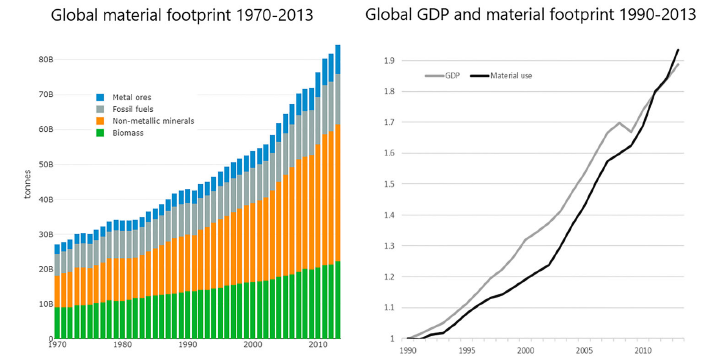There& #39;s a new book making the rounds, "More From Less", by tech guru @amcafee. McAfee argues we can have indefinite GDP growth while *reducing* our ecological impact. For evidence, he points to the US economy, which he says has dematerialized since 1980. Big claim.
Is it true?
Is it true?
McAfee& #39;s claims about dematerialization hinge on this graph. But, astonishingly, he doesn& #39;t account for the material impact of extraction & production that has been offshored since 1980. A lazy omission? Or a clever accounting trick?
What happens when we *do* account for the footprint of imports? We see that the US economy is not dematerializing at all. In fact, it has been getting *more* materially intensive. Here is a graph of real GDP and total raw material consumption in the US since 1990.
This data comes from the UN. It is easily available online. McAfee knows it exists. He also knows that RMC is the dominant measure that ecological economists use when assessing the question of decoupling. It is everywhere in the literature. Why does he ignore it?
McAfee& #39;s claim has won praise from @sapinker, @Lagarde, @noahpinion and silicon valley CEOs. He was at Davos with @MazzucatoM. These figures are lining up behind a claim that ecological economists have long rejected. Here& #39;s a review of relevant literature: https://www.tandfonline.com/doi/abs/10.1080/13563467.2019.1598964">https://www.tandfonline.com/doi/abs/1...
McAfee claims that other rich countries are decoupling too. But the data on RMC (rendered as Material Footprint, MF, in this graph) shows exactly the opposite. Not only the USA, but also the EU and the OECD have experienced zero dematerialization. Source: https://www.pnas.org/content/112/20/6271.short">https://www.pnas.org/content/1...
We can see the same pattern playing out in the world economy as a whole. Global resource use hasn& #39;t been slowing down at all; in fact it has been *accelerating* since 2000, to the point of *outstripping* the pace of GDP growth.
McAfee suggests that rich countries are the heroes, as they are "dematerializing" while poorer countries are not. But (a) rich countries are not dematerializing, and (b) rich countries are the problem here, not the solution. See graph. The red line is the sustainable level.
US raw material consumption is 35 tons per person per year. If the rest of the world consumed this much, global resource use would total 260 billion tons per year: nearly 3x the present rate, and 5x over the sustainable level. It is madness to suggest that the US is a model.
The bottom line is that McAfee& #39;s claims about dematerialization are not supported by the empirical data. This question has been rigorously examined in the academic literature; it is not clear why McAfee would choose to ignore relevant research. https://www.ncbi.nlm.nih.gov/pmc/articles/PMC5065220/">https://www.ncbi.nlm.nih.gov/pmc/artic...
I, for one, would absolutely love if it were true that GDP was rising while our impact on the living world declined. Everybody would. But there is no evidence for this. It is risky and irresponsible to rely on fairytales to inform policy. We need to be smarter than that.

 Read on Twitter
Read on Twitter






